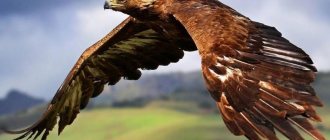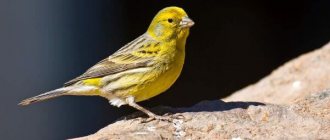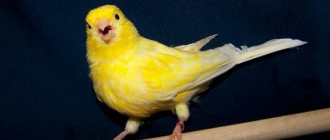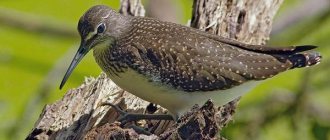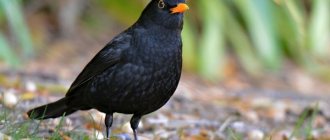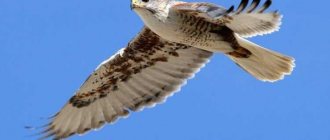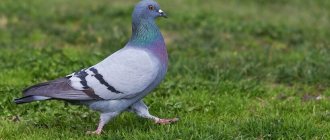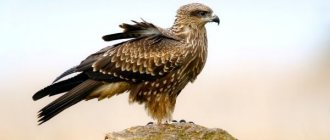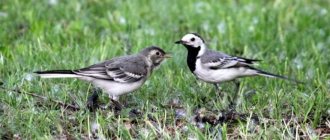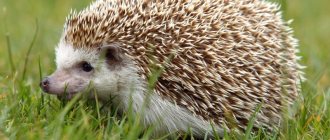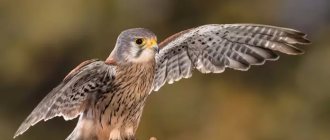Peacock bird - origin, description
Peacocks descended from ancient flightless thecodont dinosaurs. Information about their evolution has not yet been found. The ancestors of these birds did not know how to fly, and they needed feathers to protect them from the cold. Thecodonts lived during the Jurassic period and that is almost all that is known about them.
Large and bright peacock tail
The first mentions of these birds were seen in the 4th millennium BC. The inhabitants of India are the very first people to domesticate this bird. Today the peacock is a symbol of the country.
Additional Information! Peacocks are great at hunting cobras. For this reason, people in India keep them near their homes.
Mentions of these birds are also found in ancient Greek mythology. They were called the favorite bird of Hera, the patroness of marriage. In Ancient Greece, males were considered a symbol of wealth in the home and power.
Peacocks are birds with bright blue or emerald colored feathers.
Characteristics of peacocks:
- body length - 130 cm;
- tail length - up to 1.6 m;
- weight - 5 kg;
- wings 60 cm long;
- crest on the head.
The tail is divided into two parts: the rump and the tail itself. Its total length is 1.4-1.6 m.
The color of the body of birds varies depending on the sex. Females have gray, brown feathers, while males have bright feathers with shades of different colors. The neck and head are colored blue. There are species that can combine different colors on the body: red and white wings, and the body is brown with gray spots. On the feathers of birds you can often see patterns in the form of “eyes”, consisting of green, blue and yellow shades.
Their head is small. At its top there is a crest, which matches the color of the birds. The long neck helps birds maintain beautiful posture.
Peacocks belong to large birds of the Pheasant family of the Galliformes order. Pheasants are distributed throughout the planet, except for its southern and northern parts. You can meet them in Sri Lanka and India. The birds' habitat is jungles, forests, near human settlements.
Structural features
Peacocks are very large birds: their size, including their tail, is up to 2.5 meters. Although it should be clarified that the bird’s body does not exceed one meter, and the tail is only 40-50 centimeters long. But the magnificent feathers located above the tail make up the main length of the bird; they reach a size of 160 centimeters.
The Indian peacock has a bright blue main plumage color on its head, neck and chest. The back of the bird is a beautiful green with iridescent color, and the underside is black. This coloring is especially important for attracting females because the peacock has a terrible voice, like a crow. But the magnificent tail feathers look gorgeous - long, bright, decorated with an ornament that looks like many eyes. Interestingly, they serve not only to attract females, but also to protect against predators, and modern science also knows that this is one of the ways of communication.
Differences between female and male
Description of the appearance of peacocks helps to distinguish a female from a male. The coloring of males is much brighter than that of females. The former have spikes that help them in battles with other members of the species.
The female and male are significantly different
For reference! Female peacocks are called peahens. They have modest colors and short feathers.
The female needs this color to incubate eggs and raise offspring. Variegated tones are difficult to spot in the wild, which means they will not attract the attention of predators.
Peahens are smaller in size than males. The length of their body reaches 1 m. At the ends of the feathers, the female has black spots, and at the bottom of the neck - brown-green or dark blue. Their crest is small, gray and brown.
Males are much larger and more showy than females. As a rule, they have bright and long feathers. Their main function is to attract women and intimidate rivals. The feathers are colored green, emerald, blue and gold.
Several differences can be noticed in the behavior of both sexes:
- during the mating season, males spread their tails and show off their wings;
- For the sake of the peahen, the males arrange fights for her attention;
- females are almost always calm, sometimes they can be aggressive towards other peahens;
- During the mating season, males make “meowing” sounds.
Important! Female peacocks raise their offspring independently; males do not take any part in this.
Kinds
The peacock bird has two Asian species - common (Pavo cristatus) and green (Pavo muticus Linnaeus).
The second one is different in size. It is much larger than the Indian one. There is also an African species that for some reason stands apart.
How many feathers does a peacock have in its tail?
When the question arises, who is a peacock, the bird’s beautiful tail and colorful feathers immediately come to mind. The number of feathers of the bird is about 200. The main, small tail consists of 20 feathers.
The “eyes” on the tail are visible even when the bird waves it quickly. Scientists have discovered the reason for this phenomenon. The results showed that this is due to the connection of feathers with mini-hooks. They fit tightly to each other, which means they are less mobile and flexible.
The long tail of birds moves faster than the short one. During its movement, the male emits sound vibrations. A person will not be able to catch the tonality of such sounds, but peahens easily understand these signals.
The male's tail also performs a protective function. When it sees an enemy, the peacock spreads its tail. The bright color confuses the enemy and prevents him from approaching the bird.
Peacock feathers
Royal
The same white peacock, but slightly larger than its relative and with a more magnificent tail. Due to the unique color of its feathers, it is a popular inhabitant of royal gardens and private estates. Looks great when it spreads its tail and during flight.
The body dimensions, wingspan and size of tail feathers are almost identical to the white peacock. It lends itself well to breeding, but requires a special approach to feeding. Any type of peacock is unique and beautiful in its own way. According to the majority, this bird is considered the most beautiful and enjoys the well-deserved love of others. Due to the color of their long feathers, peacocks often become victims of poachers, which is why the birds have recently begun to be bred in nurseries
Dimensions and weight of the strange bird
The body length of the peahen does not exceed 1 m. The head and neck are white, and the chest is brown. The weight of the birds is from 3 to 4.5 kg. The male's body length is about 1.7 m, feathers - 1.8 m.
Green peacocks are distinguished by their metallic tail. The beak of birds is 2-3 cm long. The length of the tail depends on living conditions, gender and age.
The female chooses a partner by assessing the color and length of his feathers. The more magnificent and bright the tail, the more likely it is that the peahen will choose just such a male.
Additional Information! Female peacocks do not like to hatch eggs; they place them under other birds. But when the offspring appear, the peahens carefully take care of the little peacocks, teach them how to survive and keep them warm in winter.
№10
White peacocks are not albinos, as many people think, but a subspecies of blue peacocks (Indian) that have developed a genetic mutation. This mutation is called leucism and implies a partial loss of pigmentation of the outer covering. Leucism can lead to a complete absence of plumage color, but the normal eye color is retained, which is not typical for albinos, whose eyes become red or pink.
Varieties of peacocks
The appearance of these birds depends on what the peacock looks like. Individuals with a white color are most common.
White (albino)
People discovered albino peacocks in the 18th century. Their eyes are blue-blue. The bird is considered a symbol of grace and wealth. In some countries, white peacock feathers are a valuable interior decoration.
White peacock
Birds live in flocks, moving most of the time on their limbs rather than flying. They tolerate cold and wet weather well.
The homeland of white peacocks is India, but they are also common in Nepal, Thailand, and China. Birds prefer to live near mountains with large vegetation and agricultural lands of people.
Typically, birds are threatened by predators such as lions, leopards, and tigers. For people, the meat of these birds is considered a delicacy.
White birds can be seen in nurseries and zoos. In addition, they are bred at home. It is enough to purchase an aviary, provide the bird with comfortable conditions and good nutrition.
Black-shouldered
The Indian black-shouldered peacock differs from the representatives of its genus. This is an artificially bred species. Such birds are also called black-winged, varnished.
Black-shouldered peacock
A distinctive feature of the black-winged birds are the shoulders and wings of a blue-black color. Peahens of this breed are yellow and brown with spots.
More often, the black-shouldered peacock can be found in the eastern part of India. They love to live close to people, in comfortable conditions.
Attention! Selectors do not recommend crossing different breeds of peacocks on your own. There are books about the rules for breeding each species of this bird.
Congolese
The homeland of Congolese peacocks is Africa.
- Their head and neck are featherless and blue.
- The upper part of the body is green with violet and bronze oval spots.
- On the head there is a small crest consisting of erect feathers.
- The bird's tail is black with a greenish tint, and its beak is gray or blue.
Congolese peacock
The species is distributed in the tropics of Central Africa. Their anatomy has not yet been thoroughly studied, so the birds are listed in the Red Book.
Other colors
There are also green peacocks, which can be found in the southern parts of Asia: Indochina, Bangladesh, India, Thailand.
The length of their body reaches 3 m. The feathers are bright, and the head and neck are bright green. The area around the eyes and body are painted a rich blue color. The weight of the bird reaches 6 kg.
There are several subspecies of green peacocks: Javan, Indochinese. The first includes individuals with a golden-green scaly color. They live on the island of Java, Malaysia.
Indochinese birds are common in South-Eastern Asia. They are distinguished by the dark brown or dark green color of their necks and feathers. The color around the eyes is brighter than that of the common peacock.
Additional Information! In Africa, the mating season of peacocks occurs during the rainy season. For this reason, locals believe that Congolese peacocks can make rain.
Behavior in the wild
Despite the large tail, birds can move quickly, avoiding dense thickets. Wild birds eat almost the same as domestic representatives of the species.
In the absence of food on the ground, they easily find food inside it, feeding on worms. In the wild, birds often make calls similar to the long meow of a cat.
Their lifestyle depends on where peacocks live. For example, birds living near people are calm and even smaller in size than individuals living in the wild. These birds are shy and at any sign of fear they immediately try to run away.
Wild peacock
№7
These are quite loud and vocal birds. They usually make sounds during the rainy season, so they can be used as natural indicators of this phenomenon. They also scream early in the morning or late in the evening. They make sounds both during mating and during times of danger. In total, peacocks can make up to 11 different sounds, each of which has its own specific purpose.
Where do they live, in what countries?
Many textbooks tell where peacocks live. Most often people meet them in zoos, nature reserves, and national parks. Such birds adapt well to almost any weather conditions. But they best tolerate the humid climate of India, Nepal, Cambodia, China, and Australia.
Different types of birds live in different countries. Indian representatives of the species prefer the tropical climate of southern Asia. The birds have beautiful feathers, and their meat is highly prized by gourmets. In India, these birds are considered sacred animals; hunting them is prohibited in the country.
Javan peacocks can be found in Vietnam, Thailand, and China. They settle along rivers and swampy areas.
African peacocks are the most numerous species of all birds inhabiting Africa. You can meet them in dense and humid forests along the Congo River at an altitude of 1.5 thousand meters.
№11
As we said earlier, this bird can fly. She flies, of course, worse than her small relatives, but she can still do it. A peacock can be found sitting on a tree or stump. However, when it comes to building a nest, they always build it on the ground. To do this, the bird digs a small depression in the ground and covers it with all kinds of sticks, feathers, grass, etc.
What do peacocks eat?
Many owners of these birds wonder what do peacocks eat? Birds can eat plants, insects, reptiles, as well as snakes and rodents. Before getting a pet feathered animal, you need to study what peacocks eat.
Their main food is shoots of grain crops and fruits. Birds that live near people often feed in fields with newly planted crops. For this reason, they are considered pests.
Domestic specimens are good at scaring away poisonous snakes and can catch frogs and harmful insects.
Additional Information! In the East, it is believed that the meat of this bird can cure eye diseases, improve immunity and tone the body.
Nutrition
Brought to Europe, they were initially simply kept in cages, but with the development of zoos, other questions arose. How to tell people about what kind of bird a peacock is? Where does he live? What does it eat? The answer required learning more about their natural habitat. Interestingly, upon arriving in India, peacocks were found at altitudes of up to 2000 meters above sea level. Their favorite places were thickets of bushes located near villages and cultivated fields. This spoke about the way they fed: they feasted on grain in nearby fields.
They also ate berry bushes growing nearby. The bird does not hesitate to eat small rodents, as well as small snakes. The only condition for peacocks to live nearby is the presence of a nearby pond and separate tall trees. India is replete with such places and this is the best place for birds. In addition, Indians believe in the holiness of this bird and allow it to feed from their fields. The interesting thing is that where the peacock bird lives, there are fewer snakes and this benefits the people living nearby.
Reproduction when chicks are hatched
Males choose up to 5 pahs for breeding. During the mating season, they fluff up their tails, attracting as many females as possible.
After birds of different sexes have chosen each other, the breeding season begins, which lasts from April to September.
The female then lays eggs. She does about 3 hairstyles a year. The female incubates the eggs for a month, after which the first chicks appear. Their number can reach 10. Already on the third day, the chicks can walk, feed and drink water independently.
Peahen with babies
How long do peacocks live in the wild?
These birds live differently in the wild and outside the wild. The lifespan of domesticated individuals is 40 years, and that of birds living in the wild is 20 years. This fact is due to the fact that birds living in natural conditions are at constant risk from predators.
The number of individuals is approximately 100,000 throughout the world. To increase the life expectancy of poultry, it is recommended to provide them with peace of mind, a large aviary and high-quality food. The birds do not get along well with each other, so they should not be placed in the same enclosure. Its height should be 3-5 m.
Individuals under the age of two years are suitable for breeding. Before attempting to mate peacocks, you must carefully study the rules for breeding birds and not make a mistake with the color of the individuals.
№15
Hunting and rapid habitat loss due to pollution and deforestation have led to a significant decline in their populations. Of all three species, only the Indian peacock is not endangered, as it is protected at the legislative level in some states. As for the green and Congo peacocks, they are endangered.
We also recommend reading: Interesting facts about bats
